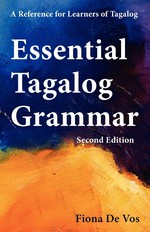Tagalog Verbs, Adjectives etc. Used as Nouns
Verbs, adjectives and other parts of speech may also be used as nouns. Examples:
|
verb/adjective/etc. |
noun |
||
|---|---|---|---|
|
kumain |
to eat, ate |
ang kumain |
the one who ate |
|
maganda |
pretty |
ang maganda |
the pretty one |
|
nasa school |
in school |
ang nasa school |
the one in school |
|
may kotse |
has a car |
ang may kotse |
the one who has a car |
|
akin |
mine |
ang akin |
the one that is mine |
|
verb/adjective/etc. |
kumain |
|
to eat, ate |
|
|
noun |
ang kumain |
|
the one who ate |
|
verb/adjective/etc. |
maganda |
|
pretty |
|
|
noun |
ang maganda |
|
the pretty one |
|
verb/adjective/etc. |
nasa school |
|
in school |
|
|
noun |
ang nasa school |
|
the one in school |
|
verb/adjective/etc. |
may kotse |
|
has a car |
|
|
noun |
ang may kotse |
|
the one who has a car |
|
verb/adjective/etc. |
akin |
|
mine |
|
|
noun |
ang akin |
|
the one that is mine |
The verb/adjective/etc. may also be preceded by ng or sa. See also: Ng markers (p. 38), Sa markers (p. 41)
|
ng kumain |
(of/by) the one who ate |
|
sa kumain |
(to etc.) the one who ate |
Examples in plural form:
|
verb/adjective/etc. |
noun |
||
|---|---|---|---|
|
kumain |
to eat, ate |
ang mga kumain |
the ones who ate |
|
maganda |
pretty |
ang magaganda, ang mga magaganda |
the pretty ones |
|
verb/adjective/etc. |
kumain |
|
to eat, ate |
|
|
noun |
ang mga kumain |
|
the ones who ate |
|
verb/adjective/etc. |
maganda |
|
pretty |
|
|
noun |
ang magaganda, ang mga magaganda |
|
the pretty ones |
See also: Plurals (p. 65)
Sentences:
|
Bago ang nasa school. |
The one in school is new. |
|
Bago ang akin. |
Mine is new. Lit. The one that is mine is new. |
|
Akin ang bago. |
The new one is mine. |
Please respect copyright. Learn more
Contents | Detailed Contents | Up ▲
See notes on Terminology and Pronunciation Marks
